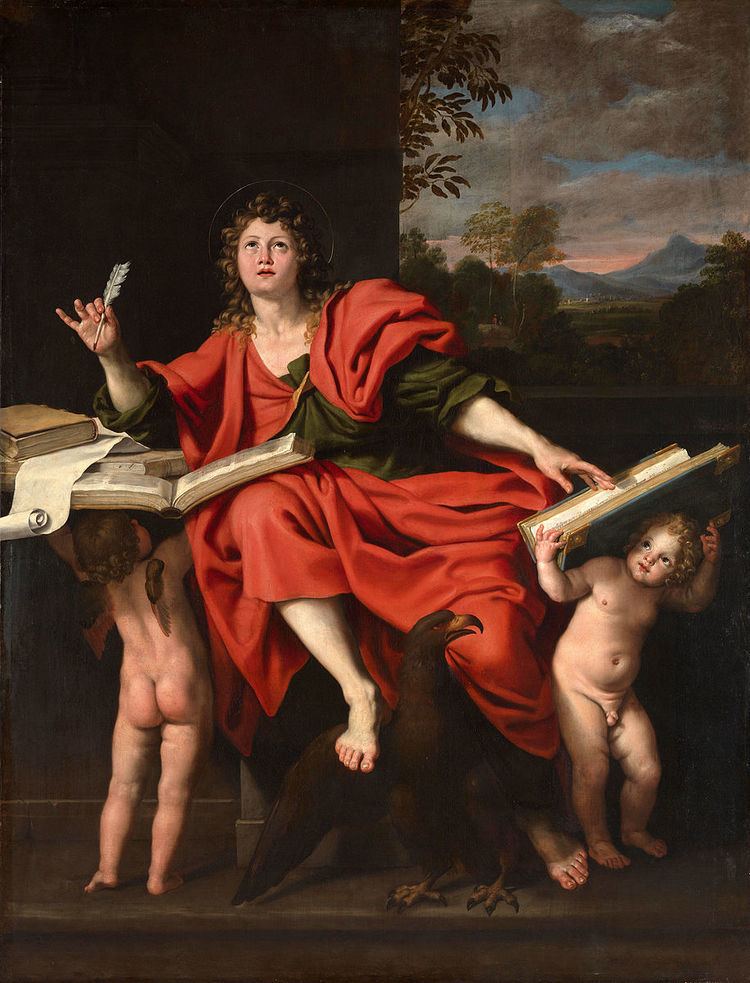 | ||
John's vision of the Son of Man is described in the scriptural Revelation 1:9-20. John sees a vision of the risen, ascended and glorified Jesus Christ, whom he describes as one "like the Son of Man" (verse 12). Jesus is portrayed in this vision as having a robe with a golden sash, white hair, eyes like blazing fire, feet like bronze and a voice like rushing waters. He holds seven stars in his right hand and has a double-edged sword coming out of his mouth.
Contents
Background
John, the author of Revelation, was exiled to the island of Patmos, possibly during the reign of the emperor Domitian. He says that on the Lord's Day he was "in the Spirit", and heard a loud voice "like a trumpet" (1:10). When he turned around, he saw this Son of Man figure. In 1:18, the figure whom John sees identifies himself as "the First and the Last," who "was dead, and behold I am alive for ever and ever" — a reference to Jesus' resurrection.
Connection with the rest of the book
Some of the language used in Revelation 1 is also used in Revelation 19 to describe the Rider on the White Horse. In both places he has a sword coming out of his mouth (1:16 and 19:15) and has "eyes like blazing fire" (1:14 and 19:12).
The Son of Man in this passage is portrayed as walking (2:1) among seven lampstands, which represent seven churches (1:20). Chapters 2 and 3 report letters written to the seven churches by John as it was revealed to him by the Son of Man. In 1:11, he says, "Write on a scroll what you see and send it to the seven churches," while throughout the letters he is identified in terms of the vision, such as "him who has the sharp, double-edged sword" (2:12).
Explanation and interpretation
William Hendriksen suggests that the whole of the vision "is symbolical of Christ, the Holy One, coming to purge His churches," and to "punish those who are persecuting His elect."
Significance of the seven stars
One aspect of the vision is the portrayal of Jesus holding seven stars in his right hand. Such a motif is also found on coins of the emperor Domitian. Sometime between 77 and 81, Domitian's infant son died. He was subsequently deified, and is portrayed on coins of Domitian, with seven stars. Ernest Janzen argues that the globe on which the infant stands represents world dominion and power, while the stars indicate his divine nature; he is depicted as "the son of (a) god" and "conqueror of the world." Austin Farrer, on the other hand, takes them to be the seven classical planets, and interprets the vision as representing Christ's lordship over time.
Although Domitian's son cannot be said to be holding the stars, some scholars have drawn parallels between the numismatic and biblical evidences. Frederick Murphy notes that "Revelation's image of Jesus with seven stars in his hand may be an allusion to that coin and an implicit critique of it. It is not the Roman imperial family that has cosmic significance, but Jesus."
John tells us in Revelation 1:20 that the seven stars are the angels of the seven churches In commenting on this verse, C.I. Scofield states: The natural explanation of the "messengers" [angels] is that they were men sent by the seven churches to ascertain the state of the aged apostle ... but they figure any who bear God's messages to a church. In the New Testament, the Greek word for angels (aggelos) is not only used for heavenly angels, but also used for human messengers, such as John the Baptist (Matthew 11:10,Mark 1:2,Luke 7:27). Merrill Unger is of the opinion that human messengers is the meaning of the stars.
